
Representatives from Havering Council attended the Launders Lane public meeting that took place at Harris Academy, Rainham, last Friday (24 November).
The Leader of the Council, Cllr Ray Morgon, joined the Chief Executive, Director of Public Health, and Director of Planning, to give a detailed update on the progress made to tackle the issues surrounding the landfill site at Launders Lane.
The Council was also joined by Laura Legate from Geo-Environmental Services Ltd (GESL), the external partner that has been carrying our extensive testing on the site to understand the level of potential contaminants.
This bulletin includes a brief update on the GESL findings and proposals, as well as a link to the full 530 page report.
Attendees also heard from Dr Mark Ansell, Director of Public Health in Havering, who gave an overview of air-quality data in the area. You can read more on this below.
The Council's Director of Planning and Enforcement, Helen Oakerbee, spoke with residents about the actions that the landowner is able to take without needing planning permission, now that the site has been analysed for hazardous materials.
The group were also joined by Alex Strand, a Station Commander from the London Fire Brigade (LFB), who spoke about the fire response over the summer, and reassured residents over ongoing safety concerns.
You can read the full report from GESL, as well as the presentations from the public meeting, on the Launders Lane page on Havering Council's website.
|
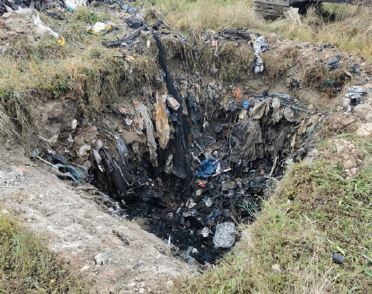
Soil testing took place on site between Monday 18 September and Friday 22 September, with external contractor Geo-Environmental Services Ltd (GESL).
A full report has been submitted to Havering Council highlighting the results of the soil testing, and recommended actions.
Report findings
Sampling took place across various points on the site, with 13 pits between up to 4.5m below ground level, and 28 boreholes up to 5.0m below ground level dug at intervals to all for samples of the soil to be collected for testing and an assessment of the landfill composition, as well as gas and groundwater monitoring.
Although it was not possible to determine specific layers that could be stated to be from the original authorised landfill site, or from subsequent unauthorised dumping, one of the pits did recover crisp packets that expired in 2011, after the landfill had closed.
|
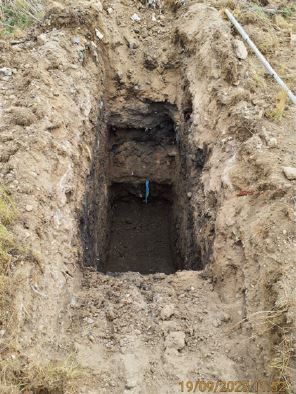
The sampling found potentially combustible materials both on the surface and in the ground, however there was no specific ignition sources found such as LPG canisters previously thought to be present.
Initial monitoring of gases below ground level indicates the presence of methane, carbon dioxide, hydrogen sulphide, as well as other volatile organic compounds. However, limited flow (movement) of the ground gases has been detected within the soil.
Ground gas monitoring is ongoing and the ground gas assessment will be updated on completion of the monitoring. Currently the last visit planned is due on Monday 4 December. Without an ignition source and where low gas flow has been identified, the risks associated with the gases in relation to off-site receptors (such as local residents) are considered to be low. Further assessment for ground gases will be provided on completion of the monitoring.
Some of the soil samples did contain hazardous materials, and the report includes a number of recommendations to minimise the risks from such material.
Recommendations
The report goes into greater details on the recommendations for mitigating the risks. These include:
- Preventing unauthorised access to the site, which will reduce any external influences which may be contributing to the fires, adding additional contaminants and disturbing existing material.
- Further consideration and assessment of ground gases (including methane) to reduce this as a potential source which could exacerbate and fuel fires..
- Capping the landfill site, which will reduce the risk of hazardous materials and fibres being released into the atmosphere.
- Continuing to monitor the site for airborne fibres to reduce health risks.
Any approved development may affect the risks highlighted in the report. You can read the full report on the website.
|
The Council has continued to work with the Environmental Research Group (ERG) at Imperial College London to analyse data from monitoring equipment installed around the Launders Lane site.
The monitors measure particulate matter and nitrogen dioxide. Data about levels of particulate matter were discussed in detail.
Particulate matter is everything in the air that isn't a gas. This includes chemicals and particles produced by industrial plants, road traffic, bonfires, wood-burners as well as wild fires.
The ERG sensors measure PM2.5 – ultra fine particles measuring 2.5 microns or less in diameter (less than 2.5 thousandths of a millimetre) that are small enough to penetrate the deep into the lungs, irritating the airways and transferring toxins to the blood stream.
In the short term, high levels of PM2.5 can trigger coughing, shortness of breath and asthma attacks, and worsen existing conditions like chronic obstructive pulmonary disease (COPD) and heart disease. Long-term exposure increases the risk of developing a range of serious conditions including COPD, heart disease, lung cancer and dementia.
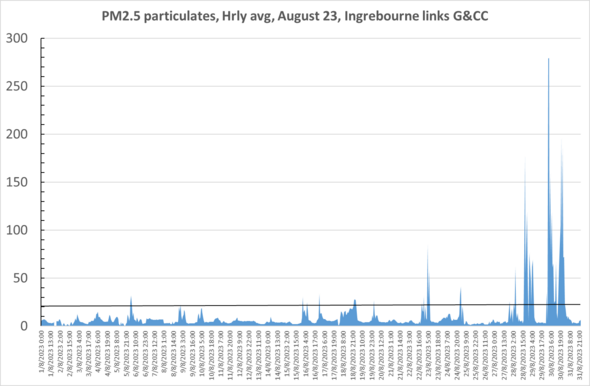 Fig. 1 - Hourly average PM 2.5 concentration at Ingrebourne Links G&CC August 2023.
The monitors around Launders Lane detected large but relatively short lived spikes in PM2.5 air pollution that coincided with the fires seen this August; with monitors downwind of the site, in this instance the Golf Course, recording much higher levels (See Fig 1).
Air pollution on Wednesday 30 August was very high at the golf course – equivalent to ‘10’ on the daily air quality index (DAQI) (see Fig 2).
 Fig. 2 - DAQI score equivalent of daily average PM2.5 concentrations at monitors in Rainham and surrounding areas during August 2023.
The DAQI is designed to help UK residents understand how predicted levels of air pollution might affect our health in the short term, so we can make informed decisions about what we will or won’t do. The DAQI scores air pollution from 1 low risk through to 10 very high.
A score of 10 indicates very high air pollution – when air pollution is this high everyone is advised to reduce physical exertion, particularly outdoors, and particularly if they experience symptoms such as cough or sore throat.
Adults and children with lung problems and older people should avoid strenuous physical activity and people with asthma may find they need to use their reliever more often. So air pollution at this level is likely to have had direct impacts on the health of residents.
 Fig.3 - Average annual concentration of PM2.5 at stated monitoring sites relative to WHO recommendation and UK limit value for period November 2022 to October 23.
On this occasion, the Fire Brigade gave advice to the management of the Golf Course to tell their patrons about the smoke plume, close windows and shut down any outside air circulation to reduce the entry of smoke into the clubhouse.
Despite these short term peaks, average annual levels of air pollution recorded by the three monitors in Rainham that have now been in place for 12 months were similar to levels recorded at monitors elsewhere in Havering and adjacent boroughs (Fig. 3).
Levels were also well below the UK national limit (20 micrograms per cubic meter, or 20µg/m3). However levels at all sites in Rainham, Havering and London were well above the World Health Organisation (WHO) recommendation of 5 µg/m3 which is a much better guide of the level to which air pollution must be reduced to avoid any harm to health.
To achieve this, we must work to tackle all avoidable sources of air pollution – including the recurrent fires at Launders Lane.
Further monitoring by a specialist contractor called TRL is underway to determine levels of specific pollutants. An analysis of NHS data is also planned to see whether more people needed help with respiratory problems during and immediately after fires. The findings of both studies will be shared with residents as soon as they are available.
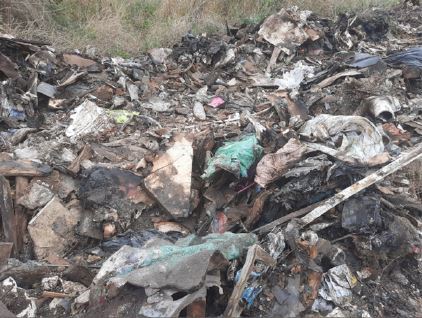
According to the London Fire Brigade (LFB), there have been no new fires on site since the last public meeting, which took place in September.
In total, the LFB has attended 19 fires at Arnolds Field in 2023, 17 of which were in August. There were four additional calls for fires in September, but no evidence of recent fires was found. Given the colder and wetter weather at this time of year, the risk to fires on the site between now and next spring is significantly reduced.
Speaking at the meeting, Station Commander Alex Strand, himself a local Rainham resident, shared the work his team have been doing on site including that, on the limited occasions where the LFB scientific advisers had been on site at the time of a fire, fire commanders were able to establish appropriate advice on smoke travel.
There is a misconception from some residents that any acrid burning smell in the area has to be coming from Launders Lane. This is not necessarily the case. The LFB has intervened with bonfires in the area in the last few weeks, and although these were on private land, some of the materials being burned included plastics, which can give off harmful chemicals, toxins and particulates into the atmosphere when burned.
The Director of Public Health advised that air pollution whether from wildfires at Launders Lane, bonfires or use of wood burners poses an avoidable risk to the health of residents particularly children, older people and people with existing respiratory conditions.
When asked by a resident if there's a chance the fires could have been started deliberately, Alex said it would be difficult to know for sure as there are so many variables (including human intervention – eg. carelessly discarded cigarettes) but it remains a possibility given the lack of ignition sources found on-site by the LFB or the GESL.
Residents should continue to follow the LFB guidance on keeping safe in the event of a fire or smoke pollution, including closing windows to minimise the risk of smoke inhalation. You must never burn household rubbish, rubber tyres or anything containing plastic, foam or paint.
|
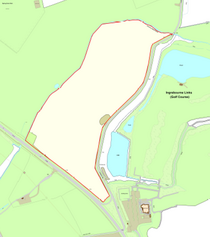
The Council remains committed to working with the landowner to resolve the issues at Launders Lane and make the site safer for residents.
According to planning enforcement laws, the removal or management of the waste material on site does not require planning permission.
Fully removing the unlawful material to comply with the Enforcement Notice also does not require permission. The landowner could have carried out these works at any time.
The report from GESL sets out a number of actions that the landowner can take to immediately reduce the risk of further fires or contamination on the site. These include capping the landfill to prevent fires, and installing fencing along the perimeter of the site to prevent trespassing and potentially further disturbing or spreading hazardous materials.
Capping the landfill site, and installation of fencing, will likely require planning permission, and the Council is willing to work with the landowner to ensure this can be achieved. To date, the landowner has not submitted any formal planning applications for the site.
|

|